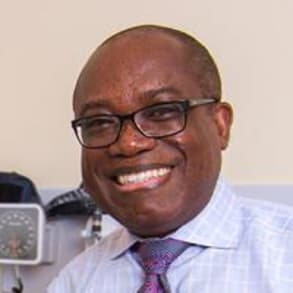Alfred Asante-Korang, M.D., medical director of the Johns Hopkins All Children’s Hospital pediatric heart transplant program, discusses the bond that develops with patient families.
I'm Doctor Alfred as Sane Karen. They call me doctor A K. I work here at Johns Hopkins, our children's hospital. I'm one of the pediatric cardiologists uh who takes care of heart transplant and heart failure patients. I'm the medical director of the heart transplant program. Transplant patients are unique in that these patients did not have any other option to live and they didn't have any surgical option and heart transplantation was really the the only treatment option that will keep them alive. These incredibly brave families spend a lot of time in the hospital waiting for transplant. They more or less live in the hospital or live in the Ronald mcdonald House, which is just outside Johns Hopkins, all children's hospital and they become part of our families because we get to see them almost every day. We are one of three programs in the state that specializes in heart failure and heart transplantation. Our outcomes are publicly reported. So I think it allows patients and families to be able to research, look at our outcomes and select the best hospital to take care of their Children. And Johns Hopkins, our children's hospital is one of the best in the state. We take care of these patients before transplantation. We also are the same team that takes care of them after they had transplant procedure and we follow them till they are ready to transition to adult uh adult care. A lot of our patients do not want to leave this hospital even though they are ready to be transitioned. They've got to 21 years old and they don't want to go. So it is rewarding that you have patients that love you and want to stay with you. We use uh a lot of echocardiogram and electrocardiogram to diagnose heart transplant rejection several years ago. The only way to diagnose heart transplant rejection is to take the patient to the Cath lab and do heart biopsies. Uh But now we rely mostly on what we call non invasive technologies. So we do a lot of echocardiograms. We do a lot of EKG S and we piece the information together to help us make a diagnosis of uh rejection. The noninvasive way of diagnosing uh heart failure or rejection is actually the future, right? Because we don't want to put these Children through heart catheterization procedures that carry risks. Uh Whereas uh doing an echocardiogram basically carries minimal risk.



